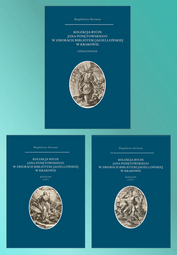Information about a product
| Edition: | 1 |
| Place and year of publication: | Warszawa 2016 |
| Publication language: | angielski |
| ISBN/ISSN: | 2083–537X |
| EAN: | 9771234541171 |
| Number of page: | 838 |
| Method of publication: | PDF |
| Size of the file: | 44,93 MB |
| Publication type: | Praca naukowa |
Rezultaty polskich badań archeologicznych prowadzonych w sezonach 2014 i 2015 na stanowiskach we wschodnim basenie Morza Śródziemnego i na Bliskim Wschodzie, od Cypru po Sudan i od Egiptu po Armenię, zostały zaprezentowane w 27 artykułach oraz w kronice projektów Centrum Archeologii Śródziemnomorskiej UW.
Pierwsza część to szczegółowe studia dotyczące różnych kategorii kultury materialnej oraz badań z zakresu nauk przyrodniczych (antropologia, archeozoologia i archeobotanika), poświęcone poszczególnym regionom (Egipt, Sudan, Liban, Kurdystan, Gruzja i Armenia).
Drugą grupę tworzy 10 artykułów studyjnych. Spośród nich 6 podejmuje zagadnienia z zakresu badań nad produkcją i użytkowaniem oraz typologią i ornamentyką starożytnej ceramiki, pochodzącej ze stanowisk z okresu neolitu w Zatoce Arabskiej, hellenistycznej i rzymskiej Fenicji, późnoantycznego Egiptu i Nubii. Szczególnym przypadkiem jest wstępne opracowanie kamiennych naczyń z islamskich warstw na wyspie Bijan. Dwa kolejne artykuły prezentują kolekcje paciorków i ozdób z dwóch stanowisk w starożytnej Nubii: Sai i Zuma.
Część studyjną otwiera artykuł poświęcony ewolucji planu architektonicznego we wczesnym neolicie na Bliskim Wschodzie, a zamyka analiza rysunku architektonicznego odkrytego na malowidle w średniowiecznej katedrze w Faras w Sudanie.
********
The results of Polish archaeological excavations carried out in 2014 and 2015 on sites in the Eastern Mediterranean and the Near East, from Cyprus to Sudan and from Egypt to Armenia, are presented in a series of 27 articles and a chronicle listing all the projects of the Polish Centre of Mediterranean Archaeology University of Warsaw. Reports detailing the excavations are supplemented by comprehensive studies of different categories of material culture as well as the nature sciences (anthropology, archaeozoology and archaeobotanics).
The second part of the volume contains 10 research articles. Six studies take up issues of ancient pottery production and usage, as well as typology and ornamentation, from the Neolithic Gulf, through Hellenistic and Roman Phoenicia, to late antique Egypt and Nubia. Stone vessels from Islamic Bijan Island constitute a special case. Two articles present collections of beads and personal adornments from two sites in ancient Nubia: Sai and Zuma. This section of the volume opens with an article on the evolution of the architectural plan in the early Neolithic in the Near East, and ends with a study of Nubian master builders based on an architectural drawing on a wall painting from the medieval cathedral in Faras in Sudan.
Drugą grupę tworzy 10 artykułów studyjnych. Spośród nich 6 podejmuje zagadnienia z zakresu badań nad produkcją i użytkowaniem oraz typologią i ornamentyką starożytnej ceramiki, pochodzącej ze stanowisk z okresu neolitu w Zatoce Arabskiej, hellenistycznej i rzymskiej Fenicji, późnoantycznego Egiptu i Nubii. Szczególnym przypadkiem jest wstępne opracowanie kamiennych naczyń z islamskich warstw na wyspie Bijan. Dwa kolejne artykuły prezentują kolekcje paciorków i ozdób z dwóch stanowisk w starożytnej Nubii: Sai i Zuma.
Część studyjną otwiera artykuł poświęcony ewolucji planu architektonicznego we wczesnym neolicie na Bliskim Wschodzie, a zamyka analiza rysunku architektonicznego odkrytego na malowidle w średniowiecznej katedrze w Faras w Sudanie.
********
The results of Polish archaeological excavations carried out in 2014 and 2015 on sites in the Eastern Mediterranean and the Near East, from Cyprus to Sudan and from Egypt to Armenia, are presented in a series of 27 articles and a chronicle listing all the projects of the Polish Centre of Mediterranean Archaeology University of Warsaw. Reports detailing the excavations are supplemented by comprehensive studies of different categories of material culture as well as the nature sciences (anthropology, archaeozoology and archaeobotanics).
The second part of the volume contains 10 research articles. Six studies take up issues of ancient pottery production and usage, as well as typology and ornamentation, from the Neolithic Gulf, through Hellenistic and Roman Phoenicia, to late antique Egypt and Nubia. Stone vessels from Islamic Bijan Island constitute a special case. Two articles present collections of beads and personal adornments from two sites in ancient Nubia: Sai and Zuma. This section of the volume opens with an article on the evolution of the architectural plan in the early Neolithic in the Near East, and ends with a study of Nubian master builders based on an architectural drawing on a wall painting from the medieval cathedral in Faras in Sudan.
Zobacz również









